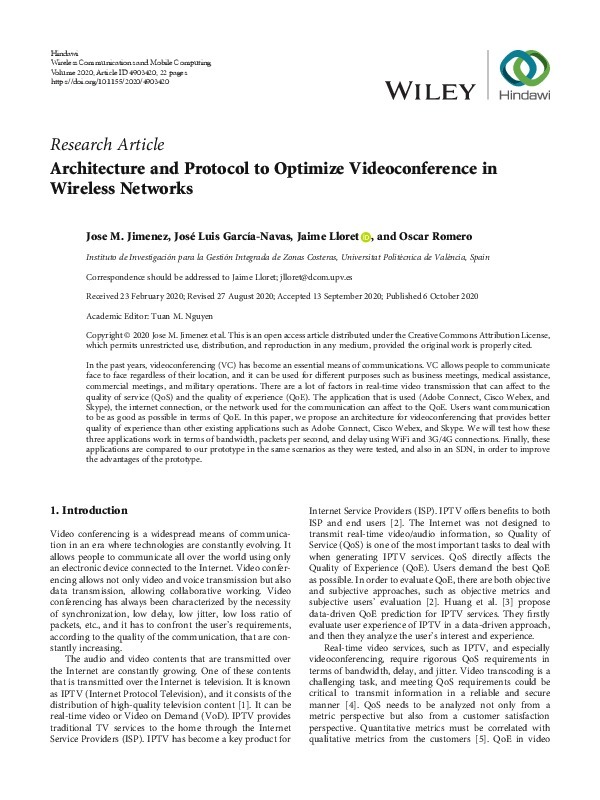JavaScript is disabled for your browser. Some features of this site may not work without it.
Buscar en RiuNet
Listar
Mi cuenta
Estadísticas
Ayuda RiuNet
Admin. UPV
Architecture and Protocol to Optimize Videoconference in Wireless Networks
Mostrar el registro sencillo del ítem
Ficheros en el ítem
| dc.contributor.author | Jimenez, Jose M.
|
es_ES |
| dc.contributor.author | García-Navas, José Luis
|
es_ES |
| dc.contributor.author | Lloret, Jaime
|
es_ES |
| dc.contributor.author | Romero Martínez, José Oscar
|
es_ES |
| dc.date.accessioned | 2021-11-05T14:08:28Z | |
| dc.date.available | 2021-11-05T14:08:28Z | |
| dc.date.issued | 2020-10-06 | es_ES |
| dc.identifier.issn | 1530-8669 | es_ES |
| dc.identifier.uri | http://hdl.handle.net/10251/176332 | |
| dc.description.abstract | [EN] In the past years, videoconferencing (VC) has become an essential means of communications. VC allows people to communicate face to face regardless of their location, and it can be used for different purposes such as business meetings, medical assistance, commercial meetings, and military operations. There are a lot of factors in real-time video transmission that can affect to the quality of service (QoS) and the quality of experience (QoE). The application that is used (Adobe Connect, Cisco Webex, and Skype), the internet connection, or the network used for the communication can affect to the QoE. Users want communication to be as good as possible in terms of QoE. In this paper, we propose an architecture for videoconferencing that provides better quality of experience than other existing applications such as Adobe Connect, Cisco Webex, and Skype. We will test how these three applications work in terms of bandwidth, packets per second, and delay using WiFi and 3G/4G connections. Finally, these applications are compared to our prototype in the same scenarios as they were tested, and also in an SDN, in order to improve the advantages of the prototype. | es_ES |
| dc.description.sponsorship | This work has been supported by the "Ministerio de Economia y Competitividad" in the "Programa Estatal de Fomento de la Investigacion Cientifica y Tecnica de Excelencia, Subprograma Estatal de Generacion de Conocimiento" within the project under Grant TIN2017-84802-C2-1-P. | es_ES |
| dc.language | Inglés | es_ES |
| dc.publisher | John Wiley & Sons | es_ES |
| dc.relation.ispartof | Wireless Communications and Mobile Computing | es_ES |
| dc.rights | Reconocimiento (by) | es_ES |
| dc.subject.classification | INGENIERIA TELEMATICA | es_ES |
| dc.title | Architecture and Protocol to Optimize Videoconference in Wireless Networks | es_ES |
| dc.type | Artículo | es_ES |
| dc.identifier.doi | 10.1155/2020/4903420 | es_ES |
| dc.relation.projectID | info:eu-repo/grantAgreement/AEI/Plan Estatal de Investigación Científica y Técnica y de Innovación 2013-2016/TIN2017-84802-C2-1-P/ES/RED COGNITIVA DEFINIDA POR SOFTWARE PARA OPTIMIZAR Y SECURIZAR TRAFICO DE INTERNET DE LAS COSAS CON INFORMACION CRITICA/ | es_ES |
| dc.rights.accessRights | Abierto | es_ES |
| dc.contributor.affiliation | Universitat Politècnica de València. Instituto de Investigación para la Gestión Integral de Zonas Costeras - Institut d'Investigació per a la Gestió Integral de Zones Costaneres | es_ES |
| dc.contributor.affiliation | Universitat Politècnica de València. Departamento de Comunicaciones - Departament de Comunicacions | es_ES |
| dc.description.bibliographicCitation | Jimenez, JM.; García-Navas, JL.; Lloret, J.; Romero Martínez, JO. (2020). Architecture and Protocol to Optimize Videoconference in Wireless Networks. Wireless Communications and Mobile Computing. 2020:1-22. https://doi.org/10.1155/2020/4903420 | es_ES |
| dc.description.accrualMethod | S | es_ES |
| dc.relation.publisherversion | https://doi.org/10.1155/2020/4903420 | es_ES |
| dc.description.upvformatpinicio | 1 | es_ES |
| dc.description.upvformatpfin | 22 | es_ES |
| dc.type.version | info:eu-repo/semantics/publishedVersion | es_ES |
| dc.description.volume | 2020 | es_ES |
| dc.relation.pasarela | S\434510 | es_ES |
| dc.contributor.funder | Agencia Estatal de Investigación | es_ES |








